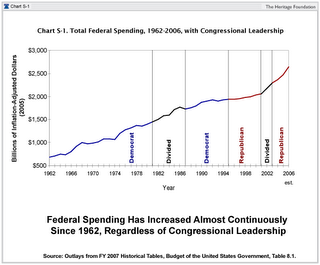... an analysis that shows military spending as a historically low percentage of GDP, demonstrating how entitlements have outpaced defense allocations from the Lyndon Johnson era to the present.
I recently had the pleasure of spending a bit of time around a few hundred young liberal activists. One refrain I heard over and over again was that the military-industrial complex in the United States was growing larger than it has ever been, taking into account the entire course of American history. Creeping toward totalitarian fascism, we apparently are.
Well, not quite. In fact, military spending is as high as it has ever been. But the American economy is also as high as it has ever been. As a percentage of the American economy, military spending today is not particularly outrageous[.]
He then displays this chart, which shows military defense spending at 3.9% of GDP in 2005 (Click on chart to enlarge):

There's one thing missing from this analysis: the 3.9% figure is based on the Defense Department's officially recognized defense spending for FY 2005, about $420.7 billion. This budget leaves out the spending for the wars in Iraq and Afghanistan, which have fallen under a series of supplemental funding bills (pdf) that totalled $420 billion between September 2001 and June 2006. Assuming this amount was instead budgeted by fiscal year in an even distribution, the real total would include another 88.4 billion in 2005, bringing actual defense spending to $509.1 billion, or 4.7% of GDP, not 3.9%.
This quibble aside, Franklin's overall argument stays strong, as total defense spending of 4.7% of GDP remains below spending for all major wars from WWII forward, on par with allocations around the first Gulf War and below expenditures during Ronald Reagan's peacetime military build-up. Strictly as a historical proportion of the US Economy, the GWoT (including Iraq) would appear to be economically sustainable, this sustainability hinging upon growth in other aspects of the budget, including entitlements.
So, that chart shows the military budget compared to the Gross Domestic Product. Now, let's look at a chart that shows the total U.S. Government Budget (Click on chart to enlarge):

Clearly, the military budget and the extra expenditures for the war are not costing us as much as we think they are.
As I recall the military budget was 30-40% of the total budget during the Reagan years. I think it may have even gone higher.
So, the point is, this war is not bankrupting us. However, that is not the same thing as saying that we are getting what we're paying for.
That part, I'm not so sure about. I think I need to study the makeup of the Iraqi Parliament.
No comments:
Post a Comment